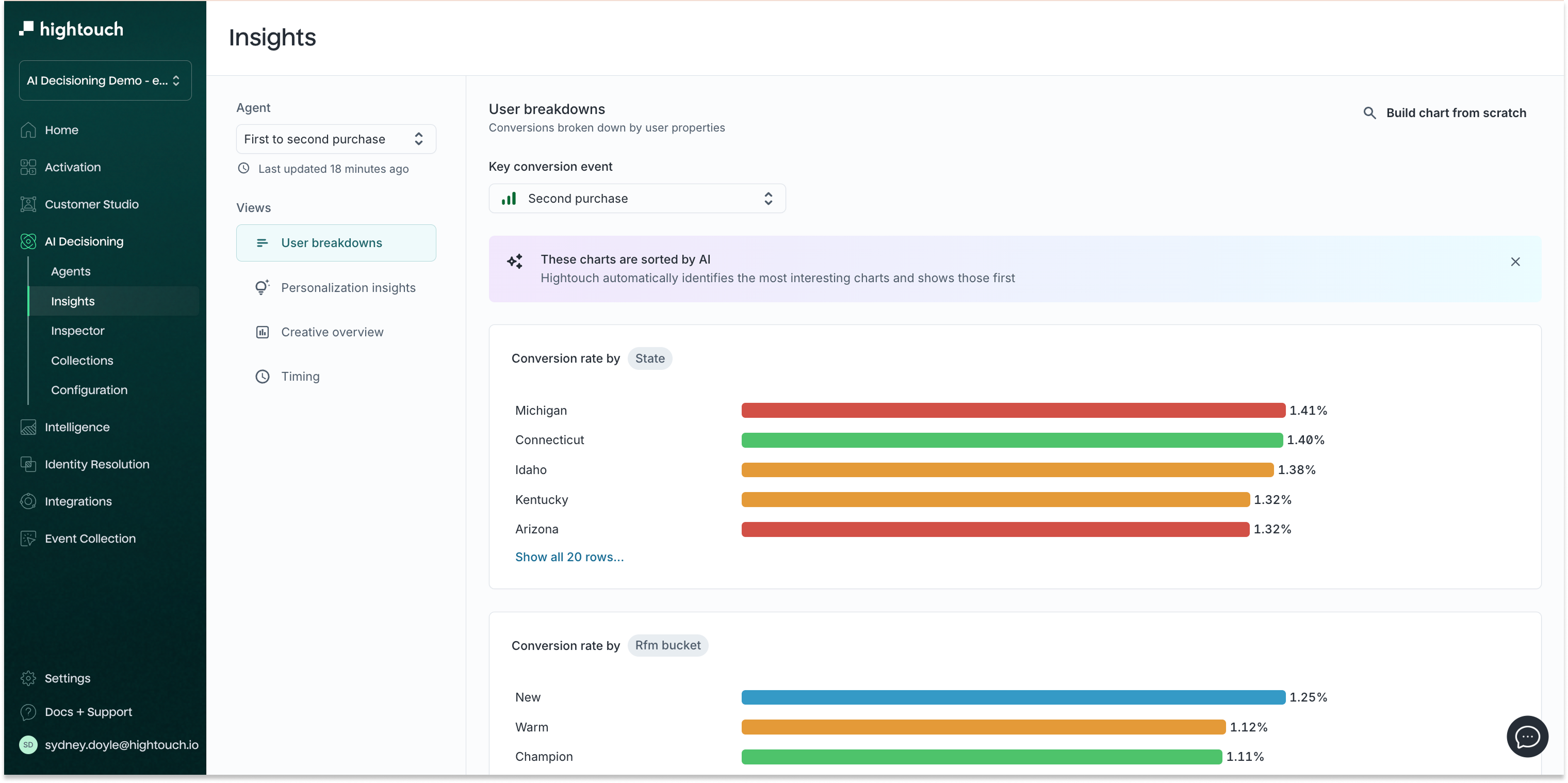Overview
AI Decisioning (AID) is a system for automating marketing decisions at the individual user level. It helps teams launch adaptive, measurable campaigns that continuously learn which messages, channels, and timings perform best for each customer.
The core unit in AI Decisioning is an agent.
Agents replace traditional, static marketing campaigns by combining everything a campaign needs to learn and improve:
- Audience – who you want to reach
- Goals – what success looks like (for example, purchases, sign-ups, or engagement)
- Messages – the emails, push notifications, or SMS variants AID can choose from
- Scheduling and guardrails – how often and when users can receive messages
- Tags – labels that describe message tone, offer, or content type
Once configured, the agent uses event data—like purchases, clicks, or app opens—as feedback signals. Over time, it learns which messages, channels, and timings are most effective for different users.
Agents operate entirely within the inputs and rules you define, they don’t create new content or act on their own.
How agents work
Agents run continuously, learning from your event data (such as purchases, opens, or clicks).
They use those feedback signals to understand which combinations of message, timing, and channel lead to the best outcomes for each user.
Each agent follows a simple loop:
- Collect inputs — Audience, goals, messages, and guardrails
- Decide — Which message to send, when, and through which channel
- Deliver — Send through your connected destinations (Braze, SFMC, Iterable, and others)
- Measure — Record outcomes such as purchases or clicks
- Learn — Update future decisions based on what worked
This process happens automatically for every user, turning each campaign into a self-improving system.

Why use AI Decisioning?
Running lifecycle campaigns manually often means writing rules or setting up endless A/B tests.
AID simplifies this by learning directly from user behavior.
With AI Decisioning, you can:
- Personalize sends automatically — Let AID decide the best message and channel for each user
- Optimize timing — Adjust delivery based on when each user is most likely to engage
- Learn what works — See which creative themes, channels, and audiences perform best
- Scale experimentation — Test thousands of small variations without manual setup
When to use AI Decisioning
AID works best for lifecycle or retention campaigns where user behavior varies across segments.
Common examples include:
| Use case | Example goal |
|---|---|
| Onboarding | Help new users complete a first purchase or app setup |
| Win-back | Re-engage lapsed users with personalized incentives |
| Cross-sell or Upsell | Recommend complementary products or upgrades |
| Referral | Encourage existing customers to invite friends |
| Retention | Keep engaged users active with timely, relevant messages |
Each agent focuses on a single measurable outcome (for example, purchases or engagement) and continuously improves performance over time.

Key components of AI Decisioning
| Component | Purpose | When to use |
|---|---|---|
| Agents | Combine your audiences, goals, and messages into a single learning system. | Every campaign starts here. |
| Messages | Add and manage creative variants from your ESP or messaging tools. | After creating an agent. |
| Tags | Label messages to group and compare creative themes. | When building or analyzing messages. |
| Smart Suppression | Reduce unnecessary sends using predictive performance data. | When optimizing for efficiency. |
| Inspector | Preview and QA the messages users receive. | After launching agents. |
| Collections | Dynamically recommend products or content from synced catalogs. | For personalized recommendations. |
| Insights | Review agent performance and identify what drives conversions. | After agents have been running. |
| Configuration | Set workspace defaults such as parent model, channels, and scheduling rules. | During initial setup. |
How learning and optimization work
AID uses reinforcement learning to balance exploration (testing new options) and optimization (sending what performs best).
Each message send contributes to what the system learns—helping future decisions become more accurate.
Performance is evaluated using your defined goals, such as purchases or clicks.
AID measures which actions lead to those outcomes, then prioritizes them in future sends.
Unlike static rules or journeys, AID adjusts automatically to seasonality, creative changes, and audience behavior.
Understand what’s working with AI Insights
AID Insights shows how your agents perform and what drives their results.
You can view:
- Conversion breakdowns by audience or segment
- Creative performance by message or tag
- Timing insights showing top-performing send windows
- Lift and confidence for each goal
These insights go beyond A/B testing by showing why a campaign works and how to apply those learnings across agents.
